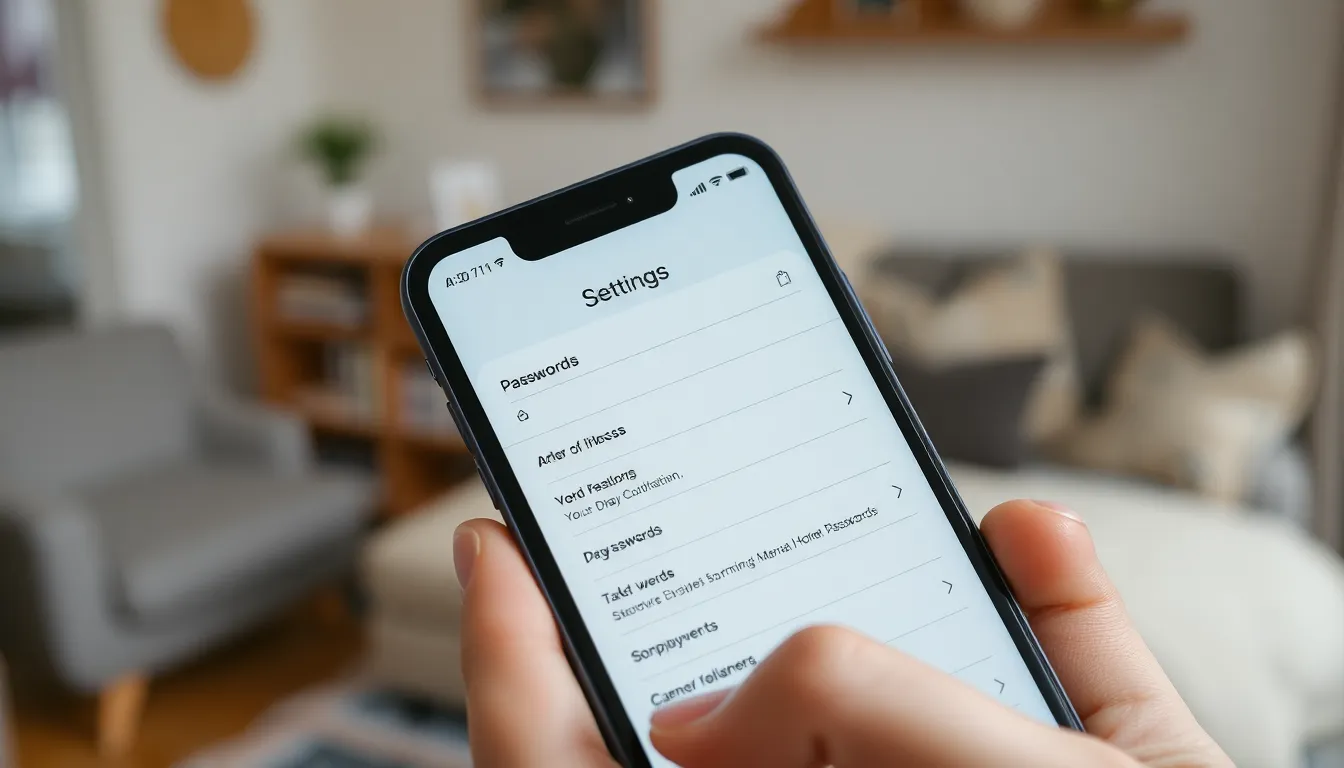Table of Contents
ToggleEver found yourself locked out of your own digital vault? Changing your Keychain password on an iPhone might seem like a task only a tech wizard could tackle, but fear not. It’s easier than trying to explain to your grandma how to send a text!
Overview of Keychain Passwords
Keychain passwords provide a secure way to store and manage sensitive information on an iPhone. This system holds passwords, credit card details, and other important data in an encrypted format. Users benefit from automatic filling of credentials in apps and browsers, increasing convenience.
Changing the Keychain password enhances security whenever there’s a concern about unauthorized access. It’s essential to remember that the Keychain password must align with the Apple ID password under certain conditions, as they share functionalities. Regular updates to the Keychain password ensure robust protection against potential threats.
The Keychain operates seamlessly in the background and allows easy retrieval of saved information. Managing multiple devices connected to the same Apple ID makes it crucial to keep the Keychain organized. Clutter within the Keychain can hinder its efficiency, necessitating periodic reviews and updates.
Recovering access to the Keychain remains straightforward with the correct steps. Users can reset an Apple ID password when they forget the Keychain password, providing another layer of security. He or she can also reset the Keychain data directly from the device settings if necessary.
Understanding how to navigate and utilize Keychain efficiently turns it into a powerful tool for maintaining personal security. An educated approach to Keychain management empowers users to safeguard their digital identities effectively. With frequent adjustments, Keychain can adapt to any changes in personal security needs.
Accessing Keychain Settings

Accessing Keychain settings on an iPhone involves a few straightforward steps. Users can navigate through their device to manage passwords and options easily.
Navigating to Passwords
Start by opening the Settings app. Scroll down and tap on Passwords. Users must authenticate with Face ID, Touch ID, or their device passcode for security. Once inside the Passwords section, individuals can view all stored passwords. Each entry provides detailed information about accounts, including website links and associated usernames.
Selecting Keychain Options
Selecting Keychain options occurs in the Settings app under Passwords. Users should look for the AutoFill Passwords toggle. This feature allows Keychain to fill in credentials automatically. Additionally, users can manage their iCloud Keychain settings by tapping on iCloud within the Settings. From there, activating or deactivating iCloud Keychain ensures that information syncs across devices. It’s essential to keep these settings updated to maintain security and functionality.
Changing Your Keychain Password
Changing the Keychain password enhances security and ensures that sensitive information remains protected. Follow these steps to update your password efficiently.
Entering Your Current Password
To begin, access the Settings app on your iPhone. Scroll down and tap on “Passwords.” After that, authenticate using Face ID, Touch ID, or your device passcode. Locate the Keychain entry to view its details. Users need to select “Change Password” to proceed. Enter the current Keychain password when prompted. This step verifies user identity before allowing changes.
Setting a New Password
Setting a new password is straightforward. After confirming the current password, users will see a field for their new password. Choose a strong and unique password to enhance security. It’s essential to use a mix of letters, numbers, and symbols. Re-enter the new password to confirm accuracy. Clicking “Save” finalizes the update, making the new password effective immediately. Regular updates to the Keychain password maintain heightened security.
Verifying Your Change
Verifying the Keychain password change ensures that the updated credentials function properly. Users should start by accessing the Settings app on their iPhone. Then, navigate to “Passwords” and select the option to view saved passwords. At this point, authentication via Face ID, Touch ID, or device passcode becomes necessary to access this section.
Next, users should locate a saved password to check if the new Keychain password works. If retrieving the password proceeds smoothly, the change is effective. In the event of issues or access denial, it indicates that the change may not have saved properly.
If errors occur, it’s advisable to repeat the password change process. Users should carefully enter both the current password and the new password, ensuring accuracy. Best practice involves saving passwords that combine letters, numbers, and symbols for optimal security.
Another useful method involves checking the iCloud Keychain on another device. By signing into the same Apple ID on an iPad or Mac, users can verify stored passwords. They should look for the same details to confirm that all devices are synced.
In addition, regular verification of passwords maintains the integrity of the Keychain. Users are encouraged to periodically check stored passwords to ensure accuracy and functionality. Keeping the Keychain organized supports overall security and convenience in managing sensitive information.
Troubleshooting Common Issues
Changing the Keychain password can encounter a few issues. Users might experience difficulty if the new password doesn’t meet security requirements. Ensure the new password includes a combination of letters, numbers, and symbols.
Accessing the Keychain settings often causes confusion. Users should confirm their identity with Face ID, Touch ID, or their device passcode each time. If authentication fails, restarting the device may resolve minor glitches.
Sync problems between devices may arise, especially if iCloud Keychain is not enabled. Verify that iCloud Keychain is turned on within settings. Toggle the feature off and on to refresh the connection if problems persist.
Specific error messages can appear while changing passwords. Read the prompts carefully, as they often provide hints on correcting the issue. Re-entering the current password correctly may help in resolving any access conflicts.
In some cases, users may forget their current Keychain password. Reset the Apple ID password if it’s difficult to retrieve. Directly resetting Keychain data might also become necessary, deleting all stored passwords as a last resort.
Tracking password updates is crucial. Access the “Passwords” section after any changes. Users confirm changes by checking saved entries to ensure proper syncing and functionality across devices.
Monitoring regularly encourages enhanced security. Schedule periodic checks of stored passwords to maintain integrity. By staying vigilant, users can continue to safeguard their sensitive information effectively.
Changing the Keychain password on an iPhone is a simple yet essential step for enhancing digital security. By following the outlined process users can ensure their sensitive information remains protected. Regularly updating the Keychain password not only safeguards against unauthorized access but also keeps the user’s data organized and accessible across devices.
Verifying the password change is crucial to confirm that everything functions smoothly. Users should make it a habit to check their stored passwords periodically to maintain security. With these practices in place users can confidently manage their digital identities and enjoy the convenience that Keychain offers.




